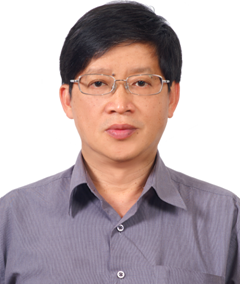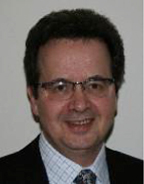|
|

Professor Fu Li
 |
| Topic: |
Spectral Modeling and Nonlinear Distortion Analysis for Wireless Communication Systems |
| Abstract: |
One of the critical and costly components in digital cellular communication systems is the RF power amplifier. Theoretically, one of the main concerns in an RF power amplifier design is the nonlinear effect of the amplifier. Quantitatively, no explicit relationship or expression currently exists between the out-of-band emission level and the nonlinearity description related to the third-order intercept point (IP3). Further, in experiments and analysis, it was discovered that, in some situations, using IP3 only is not accurate enough to describe the spectrum regrowth, especially when the fifth-order intercept point (IP5 ) is relatively not ignorable compared to the third-order inter-modulation.
In this presentation, we summarized our analysis of the nonlinear effect of an RF power amplifier for wireless systems, in particular for CDMA (IS95 Standard), TDMA (IS54 Standard), TD-SCDMA, and OFDM (IEEE 802.11x); give an expressions of the estimation of the out-of-band emission levels for each system expressed by power spectrum respectively, in terms of the IP3 and IP5, as well as the power level of the signal systems. The result will be helpful for RF engineers in the design and test of RF power amplifier for these wireless communication systems.
|
| Biography: |
Prof. Fu Li received his Ph.D. degree in electrical engineering from the University of Rhode Island in 1990. From 1989 to 1990, he was with Prime Computer, Inc. as a member of technical staff. Since 1990, he has been with Portland State University where he is currently a Professor of Electrical and Computer Engineering. He worked at Philips Laboratories in 1987. He has been a consultant for a number of companies at different times, including Intel, Tektronix, Agilent Technology, and JDS Uniphase.
Prof. Li was the associate editor of the IEEE Transactions on Signal Processing (1993-96), the column associate editor of the IEEE Signal Processing Magazine (2002). He served on various committees or chapter of IEEE societies either as a member or as the chair. He was also the general chair of the 9th IEEE-SP Workshop on Statistical Signal and Array Processing (1998).
Prof. Lií»s research interests include signal, image, and video processing, as well as wireless, network, and multimedia communications. He has published over one hundred papers in the refereed journals and international conferences.
Prof. Li is a Professional Engineer licensed in the State of Oregon. He is a member of the ETA KAPPA NU (the honor society of electrical engineering). He is a recipient of a number of awards for his technical and professional contributions, which include a Pew Teaching Leadership Award at the Second National Conference on Training and Employment of Teaching Assistants in 1989, and several IEEE awards among which he received the IEEE Outstanding Counselor Award twice, in 1995 and 2004.
He was a guest professor of Shanghai Jiaotong University, Beijing Jiaotong University, Chinese University of Electronic Science, and Sichuan University. He also worked with various industrial alliances and standardization groups in China.
|
Professor Jar-Ferr Yang

|
| Topic: |
Interactive Multimedia for Innovated Smart Living Technologies: The Development of Smart NCKU Town |
| Abstract: |
The Center for Technologies of Ubiquitous Computing and Humanity (TOUCH Center) in the National Cheng Kung University (NCKU) based on human-centric innovation has heavily adopted many interactive multimedia for development of smart living technologies.
The interactions through simple finger touch, voice, and gesture controls and virtual 3D multimedia presentations are smartly realized in several smart living products, which include 4D interactive sports, responsive garden, interactive dinner table, smart central island, ... For usability test, Aspire Home, which integrates many leading technologies and re-designed commercial appliances based on wireless OSGi platform and UPnP architecture, is also constructed through donations of cooperated companies.
Finally, the future direction of TOUCH Center through open innovation and the concept of living labs will be addressed.
Linked with ENoLL and Eurocities organization and cooperated with city government and the University, TOUCH Center plans to realize a smart NCKU town in Tainan currently.
The TOUCH Center plans to establish an integrated platform for the development of smart cities.
|
| Biography: |
Jar-Ferr Yang received his MS degree from the National Taiwan University, Taiwan in 1979, and Ph. D. degree from the University of Minnesota, Minneapolis, USA in 1988 all in electrical engineering.
He was the Chairperson of Graduate Institute of Computer and Communication Engineering and the Director of the Electrical and Information Technology Center, Currently, he is the Director of Technologies of Ubiquitous Computing and Humanity (TOUCH) Center, supported by National Science Council (NSC), Taiwan.
During 2004 - 2005, he was selected as a speaker in the Distinguished Lecturer Program by the IEEE Circuits and Systems Society.
He was the Secretary and Chair of IEEE Multimedia Systems and Applications Technical Committee during, 2006-2007 and 2008-2009, respectively.
Currently, he is the Chair of IEEE Tainan Section. He is an Associate Editor of IEEE Transaction on Circuits and Systems for Video Technology and EURASIP Journal of Advances in Signal Processing.
He is a member of the Steering Committee, IEEE Trans. on Multimedia. He is an Editorial Board Member of IET Signal Processing.
In 2008, he received the NSC Excellent Research Award. He has published over 94 journal and 142 conference papers. He is a Fellow of IEEE for his contributions to fast algorithms and efficient realization of video and audio coding.
|
Professor Fu-Chun Zeng

|
| Topic: |
Cooperative diversity for uniform data rates |
| Abstract: |
One challenge facing future wireless communications and pervasive computing is how to achieve high and uniform data rate services. Cooperative diversity (CD) via virtual antenna arrays has recently emerged as a promising strategy to address such a challenge. A major CD scheme is distributed space time block coding (D-STBC), which is structurally simple yet can potentially deliver much improved coverage and data rate. However, some critical issues, such as asynchronism and detector complexity, still remain to be investigated before D-STBC can be implemented in practice. This presentation will review these remaining issues and explore some of the possible solutions.
|
| Biography: |
Fu-Chun Zheng obtained his PhD degree in Electrical Engineering from the University of Edinburgh, UK, in 1992, and then worked as a post-doctoral research associate with the University of Bradford, UK, from 1992 to 1995. Between May 1995 and August 2007, he was with Victoria University, Melbourne, Australia, first as a lecturer and then as an associate professor (reader) in mobile communications. He joined the University of Reading, UK, in September 2007 as Professor (Chair) of Signal Processing. His research interests include signal processing for communications, multiple antenna systems, and ad hoc networking.
He has been an active IEEE member since 1995. He was an editor (2001 – 2004) of IEEE Transactions on Wireless Communications, and is a regular reviewer for many international learned journals. He has also regularly served both on the technical program committees and as the session chairs and organisers of many high profile IEEE international conferences (e.g. ICC, Globecom, VTC, WCNC, WPMC, and PIMRC, etc).
Dr Zheng also served as the general chair of IEEE VTC 2006-Spring in Melbourne, Australia (http://ieeevtc.org/vtc2006spring/) - the first ever VTC held in the southern hemisphere. Owing to the great success of VTC 2006-S, he received a VTC Chair Award from the IEEE VT Society at IEEE VTC 2009-S in April 2009 in Barcelona, Spain
|
Professor Sverrir Olafsson

|
| Topic: |
Ubiquitous and bandwidth-flexible communications via spectrum trading |
| Abstract: |
The rapid growth in the density of wireless access devices, accompanied by increasing heterogeneity in wireless technologies, requires adaptive allocation and reallocation of spectrum. The traditional allocation of spectrum does not allow for its flexible utilisation. These shortcomings call for new ways to access spectrum, for example through opportunistic spectrum usage and spectrum trading.
As technologies emerge on ever-faster time-scales spectrum trading on shorter and shorter time-scales will eventually create the basis for a real-time and liquid market in spectrum. This process will be accompanied by rapidly developing means to dynamically price the use of spectrum and provide the basis for transparency in pricing. In these liquid markets users can acquire the spectrum that best suits their needs and they will pay for it an economic price determined collectively by the market.
We will discuss scenarios where spectrum trading will happen through brokers who continuously monitor the utilisation of different frequency bands and negotiate between those who need to buy or sell spectrum. The brokers may also have the role of a market maker and as such may be required to continuously quote the price of spectrum bands on the basis of their supply and demand situation.
We will discuss scenarios where spectrum could become an asset class not only traded for hedging purposes but perhaps for speculation as well. Major investment funds may want to include spectrum in their investment portfolios for enhanced diversification and risk management.
|
| Biography: |
Sverrir Olafsson is a Professor in Risk Management at Reykjavik University in Iceland and a Visiting Professor at Queen Mary University of London.
In recent years his main focus has been on modelling utilisation of spectrum in wireless systems by the implementation of distributed optimisation techniques. With his team he has developed new approaches to dynamic power control with particular focus on stability conditions in large wireless systems. Recently this study has been extended to the development of interactive algorithms for channel optimisation and power control.
Previously Dr. Olafsson worked on self-organisation and game theory and applied it to open and dynamic service networks. His work on the usage of evolutionary game theory attracted considerable attention and has been worked on and extended by various PhD students. Dr. Olafsson has also worked on stochastic complexity and long-range correlations in data networks.
More recently his attention has been drawn to the wider aspects of spectrum management with particular attention on the commoditisation and securitisation of spectrum and spectrum trading. Of particular interest to him are questions such as: How do we price spectrum and how can network operators and service provider secure their timely access to spectrum? In his analysis he has drawn on hedging strategies based on derivative securities now widely and successfully used for the trading of conventional commodities in the financial markets.
Dr. Olafsson received his PhD in Mathematical Physics from the University of Karlsruhe in 1983. He holds five patents and has over 90 refereed publications. He is on the editorial board of; The Telecommunication Systems Journal; The Electronic Commerce Research Journal and ICST Transactions on Dynamic Resource Management.
|
|
 |
|






